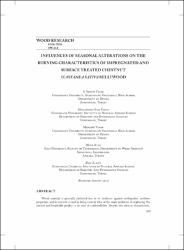INFLUENCES OF SEASONAL ALTERATIONS ON THE BURNING CHARACTERISTICS OF IMPREGNATED AND SURFACE TREATED CHESTNUT (CASTANEA SATIVA MILL) WOOD
Access
Attribution 3.0 United Statesinfo:eu-repo/semantics/closedAccesshttp://creativecommons.org/licenses/by/3.0/us/Date
2016Access
Attribution 3.0 United Statesinfo:eu-repo/semantics/closedAccesshttp://creativecommons.org/licenses/by/3.0/us/Metadata
Show full item recordAbstract
Wood material is generally preferred due to its resilience against earthquakes, aesthetic properties, and its warmth as well as being natural. One of the major problems of employing this natural and breathable product is its ease of combustibility. Despite this adverse characteristic, its high resistance against burning and its ability to maintain its weight bearing characteristics until the very end does not lead to sudden collapses as is seen in steel and concrete systems. Treating wood with impregnating materials in order to improve its resistance against burning is an improved safety measure for the prevention of ignition. This study investigate seasonal effects on the ignition characteristics of chestnut wood samples impregnated using either Tanalith-E or Wolmanit-CB as detailed in ASTM-D 1413-76 and surface-treated using water-based or synthetic varnish as detailed in ASTM-D 3023-88. The temperature of burning process was the highest in the investigated samples, in those impregnated with Wolmanit-CB and those that were treated with water-based varnish. The results of the study indicated that weight loss was lower during winter (84.59 %), for samples that were impregnated using Wolmanit-CB (84.46 %) and in those that were treated with water-based varnish (84.18 %). On the other hand, the O-2 content was determined to be the highest and the CO content the lowest in winter samples that were impregnated using Wolmanit-CB and treated with synthetic varnish.
Volume
61Issue
3Collections
The following license files are associated with this item:



















